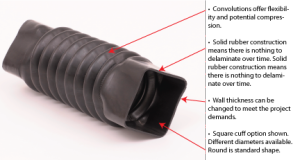Large Air Intake Design Considerations
Whether for a diesel engine or industrial blower assembly, air intakes in the 3″ to 6″ ID range can pose some unique challenges for designers. There can be negative pressure issues, bend concerns, mating and connection problems, temperature extremes, or flow rate demands, just to name a few. A great solution to these common issues is a custom made, solid rubber intake tube. Here are some key features you can expect:
** -40º to +350º F working temperature range.
** Outstanding UV and ozone resistance.
** Great flexibility, and the ability to conform to various bend configurations.
** Cuff connections that fit different diameter ends, like a 3″ ID and 4″ ID on either end.
** Vibration isolation properties.
** Availability of flame retardant and/or oil resistant blends.
Aside from vibration resistance, these features can be found in an all-metal design, but at a much higher cost. Metal connections can put vibration strain on the entire assembly, and long term corrosion issues can be a concern unless stainless steel is used, but that can certainly affect the cost. As for fabric and wire hose, it can very inexpensive, but it is also the least customized and most prone to failure. In most cases a rubber air intake hose will both outperform and be more aesthetically pleasing than a stock piece of fabric and wire hose that is roughed into place. Getting custom fit ends, if it’s even an option, can up the price. As a general rule, you won’t see nearly as good of temperature handling as with solid rubber. Perhaps the biggest point of concern is the various materials used in construction of these tubes. The fabric, plastic, and wire will tend to separate over time, fray, or unravel, and any of that would lead to product failure.
While not perfect for every application, a custom fit, solid rubber air intake hose offers fantastic value in most cases. Below is a detailed image that shows some of the key features. EPDM rubber is the most common material chosen for it’s overall weathering and temperature resistance properties, but neoprene and nitrile are also options.

Related Post
- Why Custom Rubber Tubing is a Great Choice for Medical Device Manufacturers
- An Overview of Five Popular Industrial Hoses and Their Applications
- Six Benefits of Choosing EPDM Drain Hoses for Your Facility
- Improve Your Supply Chain with Domestic Hose Solutions
- Know the Difference Between Durable Vs. Disposable Medical Tubing
- An Ultimate Guide: Choose the Right Flexible Rubber Bellows for Pumps
- Top 5 Things to Consider When Choosing Medical Hoses and Tubing
- An Overview of the Types, Benefits and Applications of Flexible Plastic Tubing and Hose
- How to Build Custom Hoses at Crushproof Tubing Company
- Factors to Consider when Choosing Industrial Hose – Part 2

